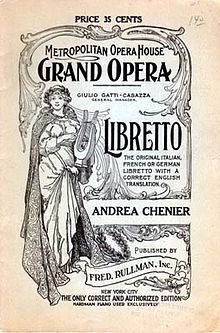
A libretto (From the Italian word libretto, lit. 'booklet') is the text used in, or intended for, an extended musical work such as an opera, operetta, masque, oratorio, cantata or musical. The term libretto is also sometimes used to refer to the text of major liturgical works, such as the Mass, requiem and sacred cantata, or the story line of a ballet.
The Italian word libretto (pronounced [liˈbretto], plural libretti [liˈbretti]) is the diminutive of the word libro ("book"). Sometimes other-language equivalents are used for libretti in that language, livret for French works, Textbuch for German and libreto for Spanish. A libretto is distinct from a synopsis or scenario of the plot, in that the libretto contains all the words and stage directions, while a synopsis summarizes the plot. Some ballet historians also use the word libretto to refer to the 15- to 40-page books which were on sale to 19th century ballet audiences in Paris and contained a very detailed description of the ballet's story, scene by scene.[1]
The relationship of the librettist (that is, the writer of a libretto) to the composer in the creation of a musical work has varied over the centuries, as have the sources and the writing techniques employed.
In the context of a modern English-language musical theatre piece, the libretto is considered to encompass both the book of the work (i.e., the spoken dialogue) and the sung lyrics.
- ^ See, for example Smith, Marian Elizabeth (2000). Ballet and Opera in the Age of Giselle. Princeton University Press. p. 3. ISBN 9780691049946.